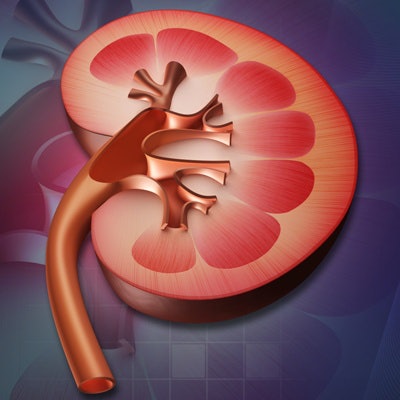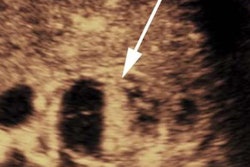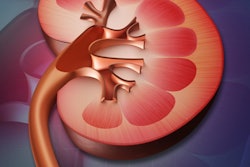
Contrast-enhanced ultrasound (CEUS) is highly sensitive for characterizing indeterminate kidney lesions, but its specificity may be low when used by inexperienced readers, as well as in patients with advanced chronic kidney disease (CKD), according to research from the University of North Carolina (UNC) at Chapel Hill.
The UNC researchers performed a study involving 44 contrast ultrasound exams that were interpreted by two readers who were experienced with abdominal ultrasound but not CEUS. They found that CEUS yielded 96% sensitivity but only 50% specificity for characterizing indeterminate kidney lesions. Specificity was particularly low in cases with advanced CKD.
"CEUS, given its safety profile, may be an alternative imaging study for patients with CKD to rule out malignancy given its excellent sensitivity, but not necessarily at this stage for us to rule-in given its specificity," said lead author Dr. Emily Chang.
She presented the findings during a scientific session at the American Institute of Ultrasound in Medicine (AIUM) annual meeting in Orlando, FL.
Incidentalomas
An increasing number of "incidentalomas" -- suspicious lesions found incidentally -- are being detected in the kidney. These can be found, for example, in patients who receive imaging during an emergency room visit for flank or abdominal pain. In addition, imaging is increasingly being ordered by nephrologists to rule out an obstruction, and also for yearly surveillance after liver transplants, Chang said.
Suspicious lesions require further evaluation, typically by contrast-enhanced CT or MRI.
"But in patients with chronic kidney disease this is often not possible, so serial noncontrast images are followed instead," she said. "This can lead to patient anxiety, so finding a contrast imaging study that's safe for patients with kidney disease would really benefit these patients."
The performance of contrast ultrasound in characterizing kidney lesions has already been extensively studied in the literature. For example, a 2014 study by Dr. Richard Barr, PhD, of Northeast Ohio Medical University in Rootstown, OH, found that CEUS yielded 100% sensitivity and excellent sensitivity (95%-96%). A number of smaller studies have also been performed, Chang said. She noted that these studies included all types of patients and were performed at centers with extensive CEUS experience.
A study involving 197 patients -- 55% of whom had impaired kidney function -- published earlier this year in Ultrasound Quarterly found that CEUS had overall accuracy of 89% in characterizing indeterminate kidney lesions, higher than conventional ultrasound and nonenhanced CT. Another retrospective analysis included 41 lesions in patients with impaired kidney function and kidney lesions, Chang said.
Comparable diagnostic accuracy?
In the current study, the researchers sought to test their hypothesis that contrast ultrasound provides comparable diagnostic accuracy to contrast-enhanced CT or MRI for diagnosing malignant kidney lesions in all patients, including those with chronic kidney disease. They recruited patients with and without kidney disease who had been referred from urology and nephrology; the nephrology referrals had kidney disease ranging from CKD stages II to IV. All patients in the study had a suspicious lesion on prior imaging, ranging from highly suspicious to indeterminate. Both solid and cystic lesions were included.
CEUS was performed on all patients and the images were deidentified and read by two blinded readers with 15 and 20 years of abdominal ultrasound experience, but no CEUS experience. After receiving a preliminary tutorial and completing a literature review, they categorized each lesion via the Bosniak criteria, which were adapted for use with CEUS. Bosniak scores of I, II, and III were considered to be negative, while scores of IV and V were positive.
Reader performance was compared with pathologic diagnosis, when available. In cases that did not have pathologic diagnosis, the results were compared with an imaging study that had been performed at a minimum of one-year follow-up. An increase or de novo appearance of suspicious characteristics was considered to be positive on the follow-up imaging study, while an increase in size was not. Lesion stability was considered to be negative.
Of the 82 patients with kidney lesions, 48 patients consented to participate in the study and received contrast ultrasound scans. Two were removed from the study due to poor technical image quality, and two more were excluded due to a lack of follow-up, leaving a final study cohort of 44 patients. Of these, 25 had chronic kidney disease and 19 did not. The 25 with chronic kidney disease included five who had tissue analysis and 20 who only had follow-up imaging. Of the 19 who did not have CKD, 18 had tissue analysis available and one only had follow-up imaging.
The researchers calculated overall reader performance in all patients and also specifically in patients who had tissue diagnosis available.
| Combined reader performance with CEUS in all patients | ||
| Patients with tissue diagnosis available | All patients (with either pathological diagnosis or 1-year follow-up imaging) | |
| Sensitivity | 95% | 96% |
| Specificity | 0% | 50% |
| Overall accuracy | 87% | 73% |
"For all patients ... [we] showed excellent sensitivity, but our specificity was very poor -- especially in comparison with the prior studies [in the literature]," she said.
The researchers also compared the performance of CEUS in a subset of 25 patients who had also received a contrast CT or MRI scan. Those CT or MRI studies were deidentified and presented to the same readers for interpretation. Chang and colleagues found that most of the misdiagnoses occurred when the CEUS study was positive but the CT or MRI was negative.
"So that can kind of give you a hint as to why our accuracy was lower," she said. "We may have overcalled with the contrast ultrasound."
CKD patients
When they analyzed performance specifically in patients with chronic kidney disease, the researchers found that sensitivity remained high, but specificity was still poor.
| Combined reader performance with CEUS in patients with CKD | ||
| Patients with pathological diagnosis | All patients (with either pathological diagnosis or 1-year follow-up imaging) | |
| Sensitivity | 90% | 90% |
| Specificity | N/A | 55% |
| Overall accuracy | 90% | 62% |
The researchers also found that the severity of CKD affected the accuracy of CEUS.
| Combined reader performance with CEUS in patients by severity of CKD | ||
| Early CKD (eGFR > 30 mL/min) | Advanced CKD (eGFR < 30 mL/min) | |
| Sensitivity | 100% | 83% |
| Specificity | 72% | 41% |
| Overall accuracy | 77% | 50% |
Theories for low specificity
Chang noted that the low specificity could be attributed to the fact that UNC was new to contrast ultrasound, with first-time readers of CEUS.
"We think they may have some overcalling," she said.
Also, patients with chronic kidney disease were included in the study, and it may be harder to be accurate in interpreting CEUS studies in patients with advanced CKD, Chang said.
Improving the accuracy of CEUS will require training for radiologists who are not familiar with the modality.
In addition, "it has been suggested recently by Dr. Barr in an editorial that we may need to develop modified criteria for CEUS given the different properties of microbubble contrast agents compared with CT/MRI contrast agents," Chang said.
Most importantly, larger multicenter studies are now needed with longer follow-up, specifically including patients with CKD, she said.



















